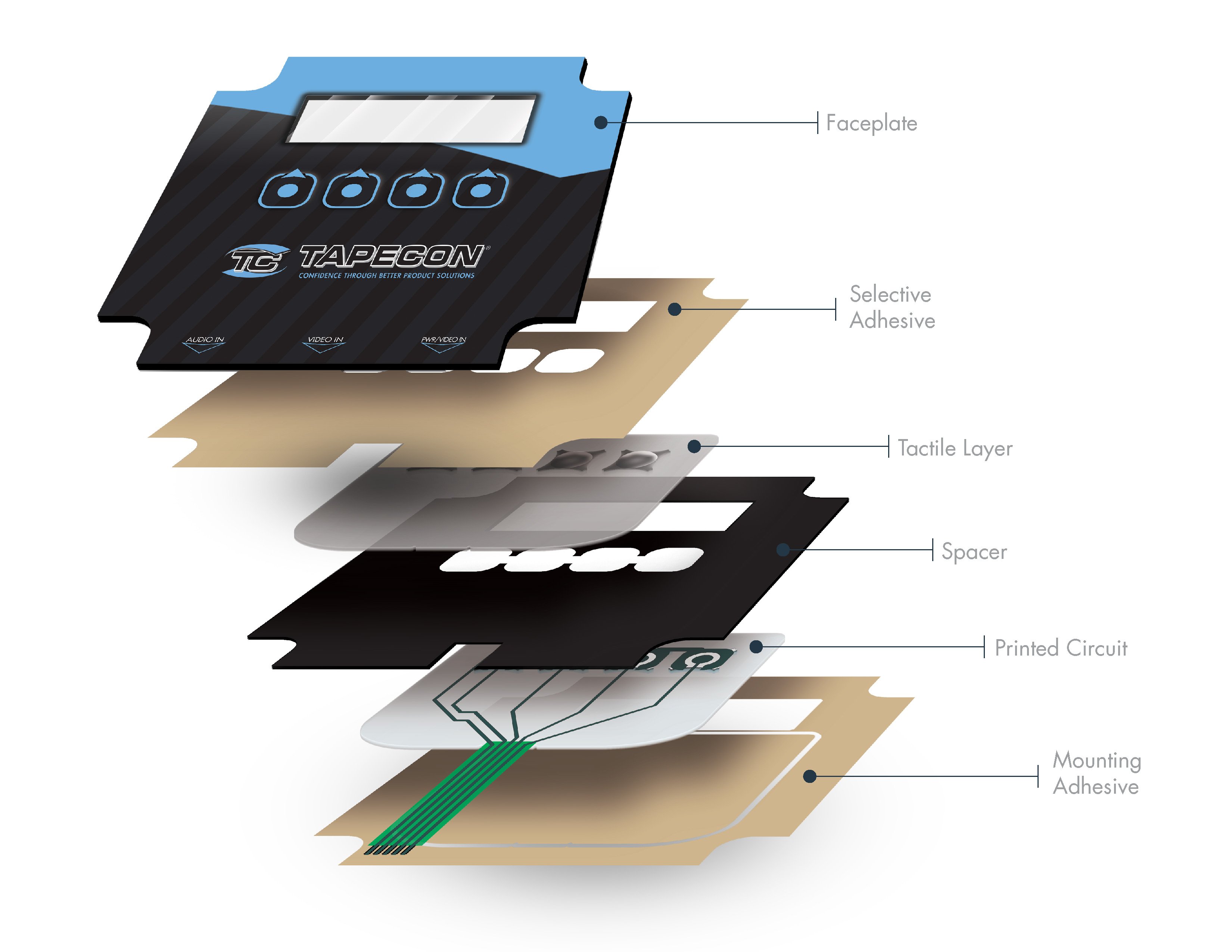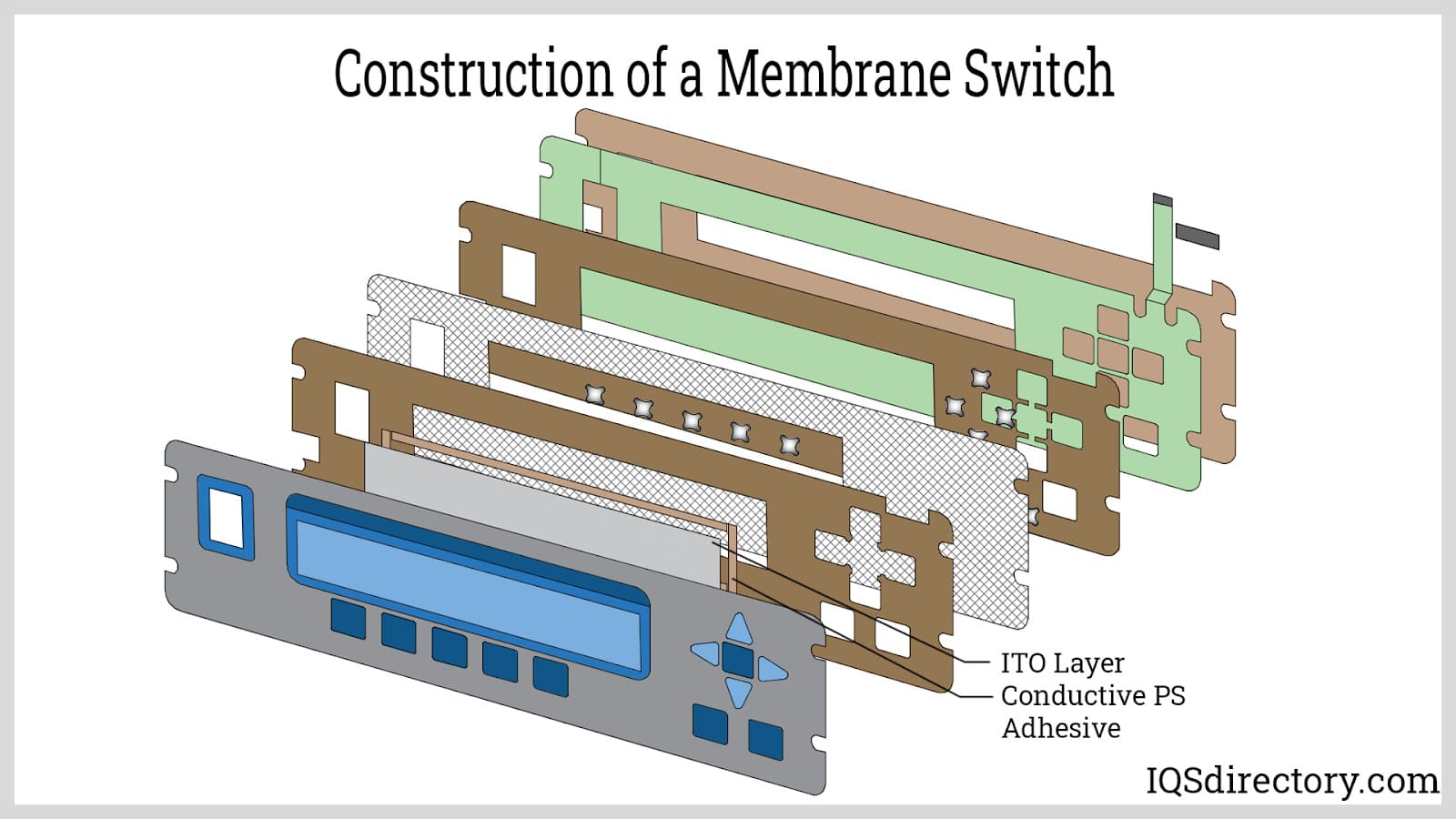The Production Process Behind Membrane Layer Switch: What You Required to Know
The production procedure behind membrane layer switches over combines careful design, material choice, and quality assurance. It begins with recognizing the ins and outs of membrane switch layout and advances with various stages, including product choices and printing strategies. Each stage plays a necessary role in making sure performance and resilience. The intricacies of layer building and the strenuous screening requirements might reveal understandings that are not immediately obvious. What lies past these fundamental components?
Understanding Membrane Switch Over Design
Membrane layer switches may appear easy at first look, their style entails elaborate factors to consider that ensure performance and durability. The design procedure starts with an extensive understanding of individual requirements, consisting of the user interface's intended application and environmental aspects. Functional designs is a crucial element, as the design has to facilitate convenience of usage while guaranteeing that responsive feedback fulfills user expectations.Moreover, the layering of components, such as graphic overlays, glue layers, and conductive traces, need to be specifically engineered. membrane switch. This split arrangement not only influences the button's responsiveness but additionally impacts its durability. Interest is provided to the securing strategies employed to protect against moisture and dust, which can jeopardize efficiency. Additionally, layout factors to consider reach looks, where shade systems and aesthetic clarity boost user experience. Inevitably, the design of membrane layer switches equilibriums capability, individual experience, and durability, making certain that they fulfill the needs of different applications properly
Products Made Use Of in Membrane Change Manufacturing
When picking products for membrane switch production, it is necessary to ponder both performance and resilience. The primary products consist of polyester and polycarbonate films, which provide versatility and strength. These movies are often covered with sticky to assure correct bonding to substratums. Conductive inks, normally made up of silver or carbon, are essential for producing electric links within the button, enabling dependable operation.Additionally, a protective layer, such as a tough layer, is often put on boost scratch resistance and longevity. The choice of backing material, such as acrylic or foam, can substantially influence the button's tactile feel and total user experience. Various environmental aspects, consisting of temperature level and moisture, ought to assist product option to guarantee peak efficiency in certain applications. Eventually, the best mix of products adds to the membrane switch's capability and life-span, making informed selections vital for makers.
The Printing Process: Creating Video and Text
The printing procedure in membrane button manufacturing plays a significant function in creating high-quality graphics and message. Various graphic style techniques are utilized to ensure aesthetic appeal and performance, while careful ink option techniques are necessary for toughness and efficiency. Understanding these aspects is basic for achieving finest lead to membrane button layout.
Graphic Layout Techniques
Graphic layout techniques play a crucial role in the printing procedure of membrane switches, as they define exactly how graphics and text will ultimately show up on the last product. Efficient graphic layout involves the strategic use formats, shades, and typefaces to improve readability and aesthetic charm. Designers typically use vector graphics for scalability, guaranteeing that images continue to be sharp at different sizes. Additionally, attention to contrast and placement is essential, as it affects individual communication and aesthetic top quality. The unification of branding components, such as logos, have to be managed with care to maintain brand integrity. Generally, thoughtful graphic style techniques add significantly to the functionality and appearance of membrane layer buttons, affecting user experience and item performance.
Ink Choice Approaches
Choosing the appropriate ink is important for accomplishing the desired visual top quality and durability in membrane layer switch manufacturing. Numerous ink types are used, including solvent-based, water-based, and UV-curable inks. Each type offers distinct characteristics, such as resistance, versatility, and attachment to ecological elements. Solvent-based inks are frequently favored for their toughness and lively colors, while water-based inks are a lot more eco-friendly however might have restrictions in attachment. UV-curable inks offer fast curing and robust efficiency. Additionally, shade matching strategies assure that the picked inks align with layout specifications. Inevitably, the selection of ink must consider variables such as application technique, substratum compatibility, and end-use needs to attain superior lead to membrane layer switch graphics and message.
Layer Building and Assembly

Product Option Refine
A mindful selection of materials is necessary get redirected here in the manufacturing procedure of membrane switches, as it directly affects capability and resilience. The key materials used include polyester, polycarbonate, and various conductive inks. Polyester is usually preferred for its exceptional resistance to chemicals and abrasion, making it suitable for extreme settings. Polycarbonate, on the other hand, offers superior clarity and impact resistance, which is helpful for applications calling for presence and toughness. Conductive inks, commonly made up of silver or carbon, are vital for developing reliable electrical paths. Furthermore, the choice of adhesive products impacts the overall integrity of the switch - membrane switch. Evaluating aspects such as environmental exposure, tactile feedback, and aesthetic demands overviews makers in selecting the most effective products for their specific applications
Layer Adhesion Techniques
Sticking layers in membrane switch construction is an important procedure that guarantees performance and longevity. Various adhesion techniques are employed to protect perfect bonding between layers, which normally include using adhesives, heat, and pressure. Pressure-sensitive adhesives (PSAs) are typically utilized for their ease of application and immediate bonding capabilities. In addition, thermal bonding methods can be applied, where warmth is made use of to activate sticky homes, protecting a strong bond. The option of attachment technique mostly relies on the materials included and the certain application demands of the membrane layer switch. Proper placement and consistent application of adhesives are important to avoid problems, protecting the switch runs efficiently throughout its desired lifespan.
Quality Assurance Actions
Assuring quality assurance during the layer building and construction and assembly of membrane switches is essential for preserving performance and reliability. This process commonly involves numerous important procedures, including comprehensive examinations at each stage of production. Manufacturers use advanced testing approaches, such as peel tests and adhesion analyses, to verify the integrity of layer bonds. In addition, visual assessments are conducted to determine any kind of flaws in printing or material incongruities. Ecological conditions, such as temperature level and moisture, are very carefully checked to guarantee excellent treating and adhesion. Normal calibration of tools aids keep exact manufacturing criteria. By carrying out these quality assurance steps, suppliers can greatly minimize the danger of product failure, assuring that the last membrane changes satisfy the needed specs and client assumptions.
Examining and High Quality Control Actions

Technologies in Membrane Layer Change Innovation
As developments in technology continue to evolve, membrane layer switches are gaining from cutting-edge developments that enhance their capability and user experience. One significant innovation is the assimilation of capacitive touch modern technology, which permits even more intuitive and responsive interface. This change not just enhances aesthetics but also lowers mechanical damage, expanding the life-span of the switches.Additionally, improvements in visuals overlay products have actually led to improved longevity and resistance to ecological factors such as moisture and UV light. These products now provide improved clearness and illumination, additional boosting the visual appeal.Furthermore, the unification of wise innovation is changing membrane changes into interactive control board, making it possible for connectivity with IoT devices. This connectivity cultivates a seamless individual experience, leading the way for applications in different markets, from healthcare to customer electronics. Collectively, these advancements setting membrane changes as critical elements in modern-day tool layout.
Regularly Asked Concerns
The length of time Does the Membrane Layer Switch Manufacturing Process Take?
The period of the membrane layer switch production process can differ substantially. Elements such as intricacy, products used, and production volume influence timelines, with normal manufacturing ranging from a couple of additional resources days to numerous weeks for conclusion.
What Are the Typical Applications for Membrane Layer Buttons?
Membrane layer switches are frequently utilized in different industries, including automobile controls, family home appliances, clinical devices, and consumer electronic devices (membrane switch). Their convenience and durability make them excellent for applications needing easy to use interfaces and reliable performance in diverse atmospheres
Can Membrane Switches Be Customized for Specific Requirements?

What Is the Life-span of a Normal Membrane Layer Switch Over?
The life expectancy of a common membrane switch varies, however typically, it ranges from 1 to 5 million cycles. Elements such as use, environment, and material quality greatly affect sturdiness and total efficiency with time.

Are Membrane Layer Switches Environmentally Friendly?
The ecological kindness of membrane layer changes varies. Some materials used might not be recyclable, while others can be green. The total effect depends upon manufacturing techniques and materials, requiring cautious factor to consider throughout choice and disposal. The manufacturing procedure behind membrane layer switches combines cautious layout, material option, and quality control. It starts with understanding the intricacies of membrane button layout and progresses with different phases, consisting of product choices and printing techniques. When picking materials for membrane layer switch manufacturing, it is essential to ponder both efficiency and resilience. A cautious choice of materials is vital in the manufacturing procedure of membrane switches, as it straight influences performance and toughness. The selection of bond technique greatly depends on the products entailed and the specific application requirements of the membrane layer button.